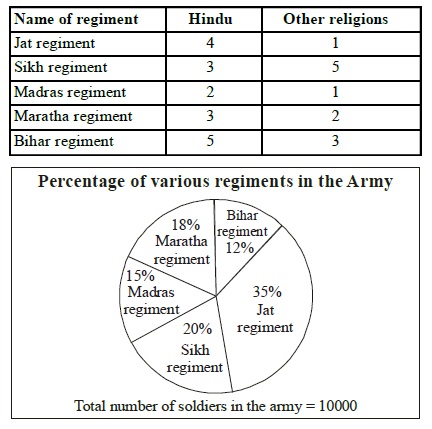(Papers) IBPS PO Exam Paper - 2015 "Held on: 4-10-2015" ::QUANTITATIVE APTITUDE::

(Papers) IBPS PO Exam Paper - 2015 "Held on: 4-10-2015"
::QUANTITATIVE APTITUDE::
DIRECTIONS (Qs. 1-5): Find the missing term.
1. 0.5, 1.5, 5, 8,76,?
(a) 380
(b) 385
(c) 390
(d) 395
(e) None of these
2. 65, 72, 86, 114 ?
(a) 160
(b) 165
(c) 170
(d) 175
(e) None of these
3. 63, 31, 15, 7, 3 ?
(a) 0
(b) 1
(c) 2
(d) 3
(e) None of these
4. 13. 70, 71, 76, ?, 81, 86, 70, 91
(a) 70
(b) 71
(c) 80
(d) 96
(e) None of these
5. 8, 43, 11, 41, ?, 39, 17
(a) 8
(b) 14
(c) 43
(d) 44
(e) None of these
DIRECTIONS (Qs. 6-10): In each of these questions, two equations (I) and (II) are given. You have to solve both the equations and give answer
(a) if x > y
(b) if x < y
(c) if x ³ y
(d) if x £ y
(e) if x = y or relation cannot be established between 'x' and 'y'.
6. I. 8x + y =10
II. 4x + 2y = 13
7. I. (x + 3) (y + 2) = 12
II. 2xy + 4x + 5y = 11
8. I. (3x – 2)/y = (3x + 6)/(y + 16)
II. (x + 2)/(y + 4) = (x + 5)/(Y + 10)
9. I. x2 + 20x + 4 = 50 – 25x
II. y2 – 10y – 24 = 0
10. I. (x2 – 10x + 16)/(x2 – 12x + 24) = 2/3
II. y2 – y – 20 = 0
DIRECTIONS (Qs. 11-15) : Study the given table carefully to answer the following questions.

11. What is the cost of flooring of A?
(a) ` 4000
(b) ` 4600
(c) ` 4800
(d) ` 5000
(e) ` 4400
12. What is the difference between the cost of fencing of C and that of B?
(a) ` 180
(b) ` 120
(c) ` 240
(d) ` 360
(e) ` 480
13. What is the ratio of the cost of flooring to that of fencing of field D?
(a) 4 : 1
(b) 6 : 1
(c) 8 : 1
(d) 9 : 1
(e) 5 : 1
14. The cost of fencing of field E is approximately what percent of the cost of flooring of field C?
(a) 10.5%
(b) 19.46%
(c) 18.71%
(d) 15.36%
(e) 13.82%
15. The cost of fencing of field C is what percent of the cost of fencing of field D?
(a) 87.54%
(b) 67.5%
(c) 72.13%
(d) 54.36%
(e) 46.5%
DIRECTIONS (Qs. 16-23) : Study the following table and pie chart carefully to answer the given questions.
The table shows the ratio of Hindu religion soldiers to soldiers of other religions

16. What is the number of Hindu soldiers in Jat regiment?
(a) 2600
(b) 2700
(c) 3200
(d) 2800
(e) 2350
17. What is the difference between Hindu soldiers in Madras regiment and soldiers of other religions in Bihar regiment?
(a) 485
(b) 550
(c) 520
(d) 510
(e) 490
DOWNLOAD IBPS PO Question Papers PDF
DOWNLOAD IBPS CLERK Question Papers PDF
DOWNLOAD MORE BANK EXAMS E-BOOKS
Printed Study Material for IBPS PO Exam
IBPS PO (Probationary Officer) Exam Study Materials
18. The number of Hindu soldiers in Sikh regiment is what percent of the number of other soldiers in Maratha regiment?
(a) 97.12%
(b) 99.56%
(c) 102%
(d) 104.16%
(e) 25%
19. In which regiment is the number of non-Hindu soldiers the maximum?
(a) Maratha regiment
(b) Sikh regiment
(c) Madras regiment
(d) Jat regiment
(e) Bihar regiment
20. What is the ratio of the number of Hindu soldiers in Bihar regiment to the number of non-Hindu soldiers in Jat regiment?
(a) 11 : 10
(b) 12 : 11
(c) 13 : 12
(d) 14 : 13
(e) 15 : 14
21. If the compound interest on an amount of ` 29000 in two years is ` 9352.5, what is the rate of interest?
(a) 11
(b) 9
(c) 15
(d) 18
(e) None of these
22. Three friends A, B and C start running around a circular stadium and complete a single round in 8, 18 and 15 seconds respectively. After how many minutes will they meet again at the starting point for the first time?
(a) 12
(b) 6
(c) 8
(d) 15
(e) 18
23. The perimeter of a square is equal to the radius of a circle having area 39424 sq cm, what is the area of square?
(a) 1225 sq cm
(b) 441 sq cm
(c) 784 sq cm
(d) Can't say
(e) None of these
DIRECTIONS (Qs. 24-26) : Study the following information carefully to answer the questions that follow-
A committee of five members is to be formed out of 5 Males, 6 Females and 3 Children. In how many different ways can it be done if-?
24. The committee should consist of 2 Males, 2 Females and 1 Child?
(a) 450
(b) 225
(c) 55
(d) 90
(e) None of these
25. The committee should include all the 3 Childs?
(a) 90
(b) 180
(c) 21
(d) 55
(e) None of these
26. Thirty men can complete a work in 36 days. In how many days can 18 men complete the same piece of work?
(a) 48
(b) 36
(c) 60
(d) 72
(e) None of these
27. Ram spends 50% of his monthly income on household items, 20% of his monthly income on buying clothes, 5% of his monthly income on medicines and saves remaining ` 11,250. What is Ram's monthly income?
(a) ` 38,200
(b) ` 34,000
(c) ` 41,600
(d) ` 45,000
(e) None of these
28. The number obtained by interchanging the two digits of a two digit number is lesser than the original number by 54. If the sum of the two digits of the number is 12, then what is the original number?
(a) 28
(b) 39
(c) 82
(d) Can't say
(e) None of these
29. At present Geeta is eight times her daughter's age. Eight years from now, the ratio of the ages of Geeta and her daughter will be 10 : 3 respectively. What is Geeta's present age ?
(a) 32 years
(b) 40 years
(c) 36 years
(d) Can't say
(e) None of these
30. In how many different ways can 4 boys and 3 girls be arranged in a row such that all the boys stand together and all the girls stand together ?
(a) 75
(b) 576
(c) 288
(d) 24
(e) None of these
DIRECTIONS (Qs. 31-35) : What approximate value will come in place of question mark (?) inthe following questions (You are not expected to calculate the exact value).
31. 9228.789 – 5021.832 + 1496.989 = ?
(a) 6500
(b) 6000
(c) 6300
(d) 5700
(e) 5100
32. 1002 ÷ 49 × 99 – 1299 = ?
(a) 700
(b) 600
(c) 900
(d) 250
(e) 400
33. 29.8% of 260 + 60.01% of 510 - 103.57 = ?
(a) 450
(b) 320
(c) 210
(d) 280
(e) 350
34. (21.98)2 – (25.02)2 + (13.03)2 = ?
(a) 25
(b) 120
(c) 10
(d) 65
(e) 140
35. √24.98 x √(625 ) x √99 = ?
(a) 110
(b) 90
(c) 200
(d) 160
(e) 125

